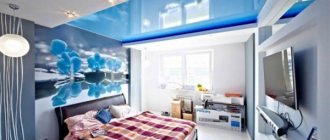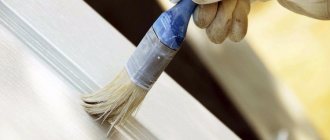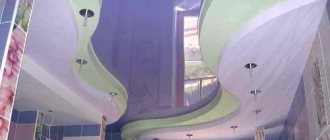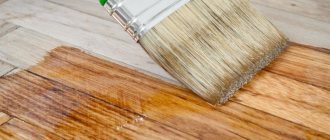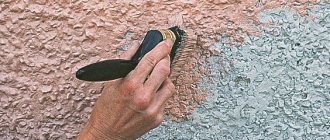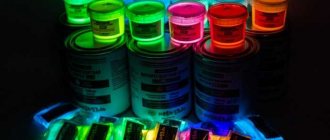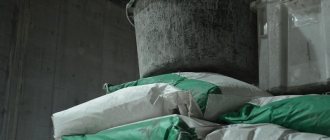CV paints for facades in their composition are a suspension of natural or synthetic pigments in perchlorovinyl resins.
These materials are used for outdoor work where protection from aggressive environmental influences (for example, precipitation) is required.
Perchlorovinyl paints (PV) have bright, saturated colors, they dry relatively quickly, and have excellent adhesion to concrete surfaces, which makes them widely used everywhere.
[contents]
What types of PVC paints are there?
There are three main types of coloring compositions. Each is based on a solution of perchlorovinyl plus various additives and solvents.
- Grade XB-125 is a fine suspension of aluminum powder, talc in a solution of polyvinyl chloride and alkyd resins. To give the desired consistency, light organic solvents and plasticizing additives are added to the mixture. Excellent for painting wood and metal. Typically used without prior priming.
- Perchlorvinyl facade paint XB 161 has technical characteristics that allow it to be used on plastered and brick walls. For its production, 10% PVC varnish with pigments and additives is used. Contains up to 47% non-volatile substances. Endowed with the lowest ability to thicken at low temperatures.
- The XB 182 modification requires preliminary priming of the surface. It is most often used for decorative finishing of concrete, stone, brick. Non-volatile components make up from 37 to 46% of the total mass. Can be used at outdoor temperatures from -20°C to +40°C.
In addition to paints, manufacturers also produce perchlorovinyl vinyl primers and putties. If it is necessary to pre-treat surfaces, it is necessary to use materials that have the same base. Otherwise, the front layer may be separated from the base due to incompatibility of the components.
Application area
The main use of facade paint is in building materials:
- Brick.
- Plaster compositions.
- Concrete.
| Surface material | Facade paint base | ||||||||||||||
| Vinyl | Acrylic | Silicone | Acrylic and silicone | Lime | Silicate | Polysilicate | Cement | ||||||||
| Concrete | No | Yes | Yes | Yes | No | Yes | Yes | No | |||||||
| Ceramic brick | No | Yes | Yes | Yes | Yes | Yes | No | Yes | |||||||
| Sand-lime brick | No | No | No | No | No | Yes | Yes | Yes | |||||||
| Cement-lime and cement plaster | No | No | No | No | No | Yes | Yes | Yes | |||||||
| Plaster based on liquid glass (silicate) | Yes (only after priming the walls) | Yes | Yes | Yes | Yes | ||||||||||
| Lime paints and plaster | No | No | No | No | Yes | Yes | Yes | Yes | |||||||
| Organic plasters and paints (made from artificial resins) | No | Yes | Yes | Yes | No | No | Yes | No | |||||||
At the same time, there are also materials that were specialized for wood or metal. In general, such paints have a wide range of specifications in order to be used in a variety of conditions where standard materials would not be suitable. For example, there are materials for finishing ships that are used in sea or fresh water, metal structures, chemical equipment, etc.
Basic properties of the material
Perchlorovinyl facade paints are inexpensive and provide good protection to the external surfaces of walls. Easy to apply and long lasting. The main characteristics of the material are presented in the following table:
| Indicator name | Unit | Quantity |
| Viscosity | Pa. With | 30-45 |
| Drying time | hour | 24 (at temperature +20°) |
| Consumption | g/m2 | up to 270 (with a layer thickness of 25 microns) |
| Grinding degree | µm | up to 30 |
The viscosity indicator indicates that paints made on the basis of perchlorovinyl resin can be successfully applied using spray guns or other sprayers. You just need to remember the safety rules. Since these dyes emit volatile substances when applied and dried, you must work in a respirator, goggles and gloves.
The advantages of PVC paints include:
- the ability to create a powerful coating that perfectly protects the surface of the walls from any external influences;
- high adhesion to the finished surface of almost any material - concrete, wood, brick and blocks, as well as to plastered facades;
- the ability to perform painting work at sub-zero temperatures.
Perchlorovinyl facade paints offer a wide range of rich, deep colors. The surface they paint retains its original appearance for many years.
Recommendations for use and application
Before applying paint, you need to carefully check the surface to be painted.
In order for the quality of work to be ideal , it is necessary that there are no flaws or cracks in the plaster, it must be dry and absolutely clean. The same applies to brick and concrete.
If the wall was previously painted with silicate, acrylic, flint-organic, or any other paint, then you will have to clean the entire surface before painting. following should be taken into account :
- Carefully prime the prepared wall surface (HFG primer or chalk with perchlorovinyl varnish). If the paint contains zinc white, the facades should be painted twice.
- Before starting work, you need to thoroughly mix all the paint to prevent it from thickening and forming lumps during the work.
- Apply the second layer only after the first has dried.
- During work, use goggles, a protective mask and gloves.
How to prepare a facade for painting is described in the video below:
HV paint can be applied not only with a spray, but also with a roller or brush. If the viscosity of the paint is high for the use of a pneumatic sprayer, then you can dilute it with solvent R-4 , solvent or xylene.
A paint sprayer gives better performance , but painting with a fur roller makes the surface better.
You should be very careful when storing PVC and CV paints, as they contain flammable solvents. The paint can must be tightly closed, and the temperature in the storage room should not exceed 10°C.
You may be interested in an article about silicone paints, their properties and applications.
Some negative qualities
PVC paints have few disadvantages, and you also need to know about them.
- Only a completely dry façade should be painted, in the complete absence of rain or snowfall. Otherwise, adhesion may not be complete.
- In the same way, direct sunlight should be avoided while working and drying. They contribute to accelerated drying with the appearance of cracks.
- It is not advisable to paint newly built houses with perchlorovinyl paints. You need to wait until they shrink to their maximum and only then start finishing. Since perchlorovinyl-based paints create a dense surface, but not plastic. As the building shrinks, it may crack.
Hence the conclusion - for finishing you need to choose dry, warm weather that is not too sunny. There is no point in experimenting with new buildings.
Technical characteristics of perchlorovinyl facade paints (including ХВ-161) + GOST
Finishing work serves two main purposes. The first, the most obvious and the main one for most, is the creation of a decorative shell, an elegant external appearance of the building.
The second task lies in the plane of materials science and does not appear outwardly in any way, but its importance does not decrease from this. This is the protection of wall materials from the adverse effects of atmospheric moisture, low temperatures and other factors that pose a threat to building materials.
The very first layer that takes the maximum load is the façade paint, which serves as a protective barrier for all wall materials. The durability of all exterior finishing depends on its quality and performance characteristics, which ultimately determines the frequency and amount of costs for cosmetic repairs.
Staining procedure
Painting with any coloring composition requires preliminary preparation of the surface, and PVC paints are no exception. We have already said that only a building that has gone through a full shrinkage cycle, and therefore not new, should be painted. Therefore, special attention must be paid to cleaning the walls and done thoroughly.
- Concrete, stone or block walls are best treated with a sandblaster. Sand will not only remove old paint well, but will also create the necessary roughness on the surface for better adhesion.
- In the case of installing an insulating layer, a reinforcing mesh must be strengthened on top of it. Next comes the procedure for applying façade putty perchlorovinyl grade XB. Drying. The issue of polishing is decided by the developer in each case separately. Most often it is not needed, this will ensure better adhesion of the paint to the base.
- When it comes to finishing a wooden house, it must first of all be treated with antiseptics and fire retardants. After drying, coat with XB primer.
- It is more convenient to apply paint with a spray gun or roller. Work begins from the top of the wall, working downwards. It is not advisable to use circular movements. To make the surface brighter and more saturated, it is better to use two layers.
You can avoid unnecessary transitions by painting the entire wall in one go. When purchasing paint, you need to take into account that for painting in two layers, the consumption of PVC paint will increase to 400 g/m2.
In addition, remember that real perchlorovinyl paint on the can is accompanied by instructions for use and a link to GOST 25129-82. Everything else is fake.
- Exterior finishing
Coating characteristics
The painted surface obtained in this way after drying has excellent decorative properties and meets all modern requirements for architectural objects. The film of this coating has vapor permeability and water-repellent properties, which makes perchlorovinyl paint an ideal coating for the so-called “wet” facade.
In addition, it gives the coating good protective and anti-corrosion characteristics. The paint has a high degree of weather and oil and petrol resistance, as well as resistance to mechanical stress. The use of perchlorovinyl compounds is recommended in areas with unfavorable environmental conditions, characterized by alkaline and acidic precipitation.
Storage of perchlorovinyl paint materials should be carried out in factory barrels or cans. Their lids must be tightly sealed to prevent leakage or evaporation of flammable solvents contained in the paint. A loose fit of the sealing elements of the container is also fraught with the evaporation of volatile solvents, without which the paint dries without the possibility of its subsequent dilution.
READ MORE: Do-it-yourself concrete blind area made of bricks and pebbles, insulated device technology and materials
is distinguished by two factors at once: high price and very high quality, which, first of all, is expressed in the strength of the finished finish. Experts recommend approaching the preparation of the surface that is planned to be painted with this type of paint and varnish material with special care.
For example, it is best to remove old paint from the facade of a building using a special sandblasting machine, which will remove every particle of it.
Description, composition, GOST
The components used in the product are perchlorovinyl resin, fillers and dyes. The resulting layer is distinguished by its strength, serving as effective surface protection and versatility.
Perchlorovinyl paint GOST 25129-82 regulates the production of these products. Therefore, when purchasing, it is necessary to check the availability of certificates of conformity and quality from the seller. The peculiarity of the composition is its resistance to high-temperature influences, and low-temperature ones too; it does not harden at -20 degrees. This allows painting in both hot and cold weather.
A wide range of color solutions makes it possible to choose the best option for painting the surface. Allows the walls to “breathe”, creates an elastic coating, and reduces the effect of moisture on the base.
A wide range of color solutions makes it possible to choose the best option for painting the surface.
What you should know
A few more interesting points:
- On average, consumption ranges from 150 to 230 g/m2. With a two-layer coating, the consumption increases to 400 g/m2.
- You should know GOST for perchlorovinyl paints - 25129-82, since all other products with the same name, but a different code, may be fakes.
- Operational life is at least 10 years. But if stored incorrectly, it can last for a year, after which it can be destroyed.
- Do not keep the container in the sun or in rooms with temperatures below 40 degrees.
Now you know all the features of perchlorovinyl paints, which are ideal for finishing facades. You can learn more about the application process from the video located here.


